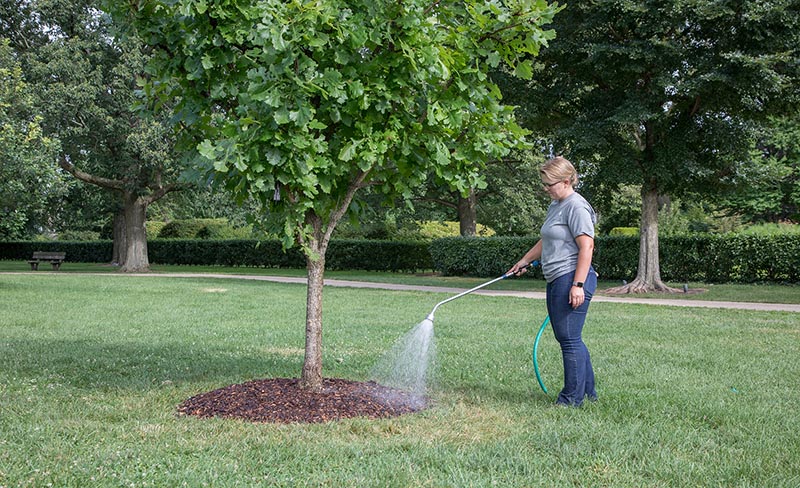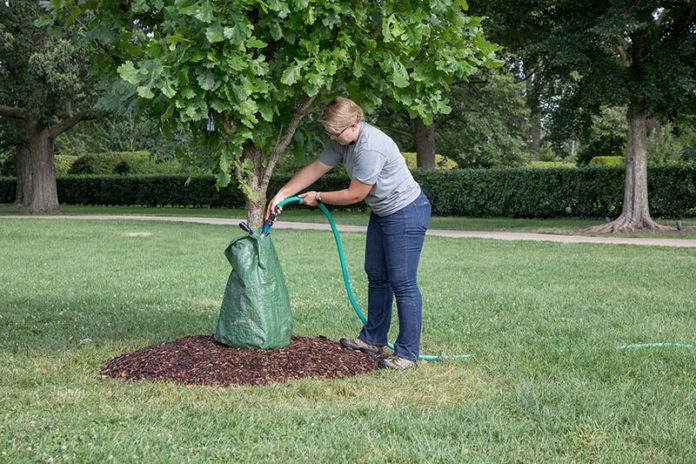LISLE, Ill. (June 22, 2023)—This summer is getting off to an unusually dry start, with The Morton Arboretum in Lisle, Ill. recording its driest period from April 1 to mid-June since 1936 and the Illinois State Climatologist reporting it as the second driest on record statewide.
To help keep trees and all plants healthy through this dry spell, Arboretum experts are urging homeowners and others to water trees and plants more often than usual to prevent drought stress, which happens when soil water becomes limited.
Under drought stress, young roots on many trees are weakened and some are killed outright, reducing the plant’s ability to absorb sufficient water. If landscape plants—including trees, shrubs and ground covers, especially evergreen types—do not receive adequate rainfall or supplemental watering, damage to or loss of foliage, or even all-out mortality, is likely.

“In this stressful time for trees and plants, it’s important to understand and provide the special care they need,” said Spencer Campbell, the Arboretum’s Plant Clinic manager. “Wilting leaves are a sign of drought stress, but it’s better to keep plants supplied with enough water before they get stressed enough to wilt.”
Depending on air temperatures, trees and shrubs need at least 1 inch of water applied deeply through a long, slow soak every week to 10 days to cope with lack of rain, Campbell noted. Larger, established trees have wide-spreading root systems and need not be watered as frequently, perhaps every two to three weeks. Let the top few inches of soil dry out between watering to avoid saturation and to allow roots and soil organisms to breathe, Campbell said.
Here are additional tips from The Morton Arboretum for watering trees and plants during drought conditions.
- 1. Check for soil moisture. Rather than watering on a set schedule, check the garden soil for moisture. This practice is better for the plants and helps conserve water. Since plants absorb water through their underground roots, the amount of water in the soil is what matters to them. Dig down a couple of inches, and if the soil feels dry, it’s time to water. Bear in mind that soil conditions may not be the same in all parts of a yard.
- 2. Use proper watering techniques. Trees and plants can only absorb water through their roots. Because much of tree roots are below the surface, it’s important to apply water relatively slowly so there’s deeper infiltration. Soaker hoses, which are laid on the soil surface to slowly seep water, are more efficient than sprinklers, although a sprinkler can cover a wide area. Be aware that the spray from a sprinkler can be blocked or diverted by trees, shrubs or even the large leaves of some plants such as hostas. When watering by hand with a hose nozzle or watering wand, direct the water toward the base of the plant.
- 3. Certain plants need more frequent watering. Containers, vegetable gardens and newly planted perennials may need watering every couple of days or even more often in hot weather.
- 4. Young plants need more help accessing water. It’s especially important to provide more water for young, newly planted trees, which don’t have many roots yet. Let the hose dribble slowly into the soil, moving it around to moisten the soil around the trunk. A good dose for a young tree a few feet tall is about 10 gallons—roughly the amount resulting from a hose running at medium pressure for five minutes.
- 5. Mature trees need watering too. Even mature trees need watering in hot, dry weather. If the hose won’t reach, pour several buckets of water slowly into the soil around the tree.
The Morton Arboretum’s scientists are closely monitoring the drought and its impacts. Through a recently awarded grant from the National Oceanic and Atmospheric Administration (NOAA), the Arboretum is collaborating with three other major Illinois research institutions to improve urban forest drought resilience.
“With the region currently experiencing abnormal drought conditions, and climate change likely to make droughts and excessive heat events more common, we must ensure urban trees are healthy,” said Christy Rollinson, Ph.D., the Arboretum’s forest ecologist and the drought resilience project leader. “Trees help keep cities cooler in the summer and provide many more valuable ecological services to help mitigate impacts of climate change. Many of these services are dependent on trees having access to water, so proper watering and care are essential to climate resilience.”
More information about how to keep plants healthy during drought is available on the mortonarb.org website or by visiting, emailing or calling the Arboretum’s Plant Clinic during operating hours.
About The Morton Arboretum
The Morton Arboretum is a world-renowned leader in tree science and research. Its 1,700 acre site cares for 222,000 tree and plant specimens, representing 4,650 taxa from 40 countries. The Arboretum’s Center for Tree Science collaborates with researchers around the world, contributing scientific knowledge and technical experience to secure the future of trees. The Arboretum’s Global Tree Conservation Program leverages the expertise of the botanical garden community to protect and restore vulnerable and threatened trees. Its new Center for Species Survival: Trees, is the only tree-focused center designated by the Species Survival Commission (SSC) of the International Union for Conservation of Nature (IUCN), the world’s largest conservation organization. Additional information about the Arboretum’s scientific work and how it contributes to a greener, healthier world for future generations can be found at mortonarb.org.



















































